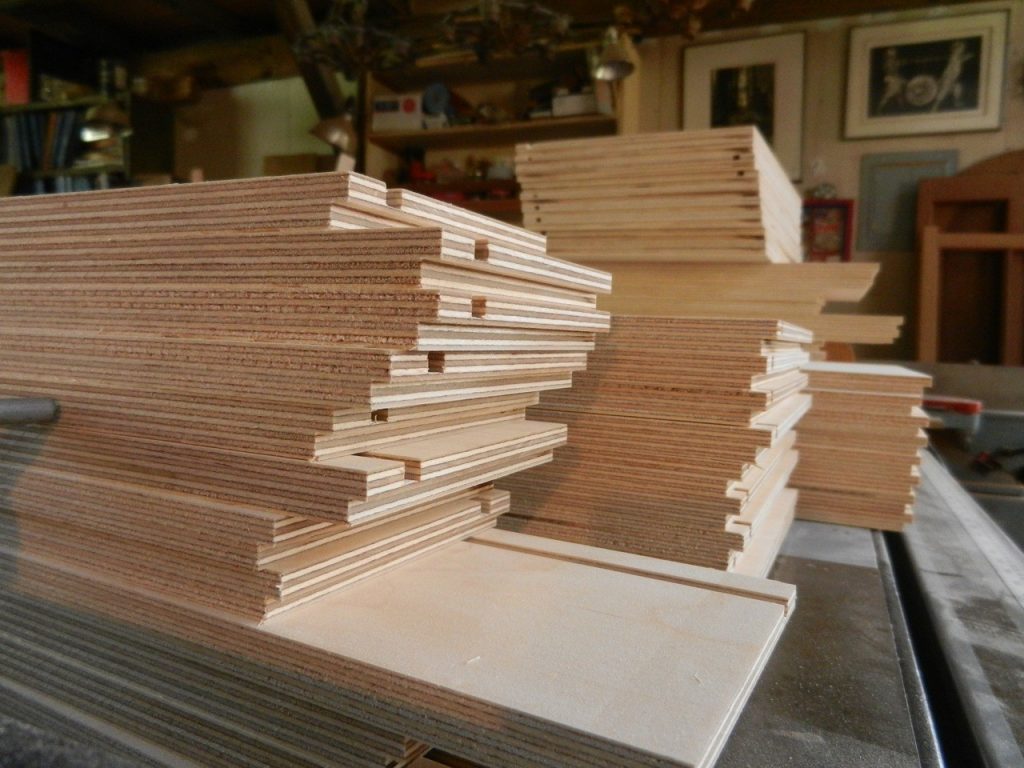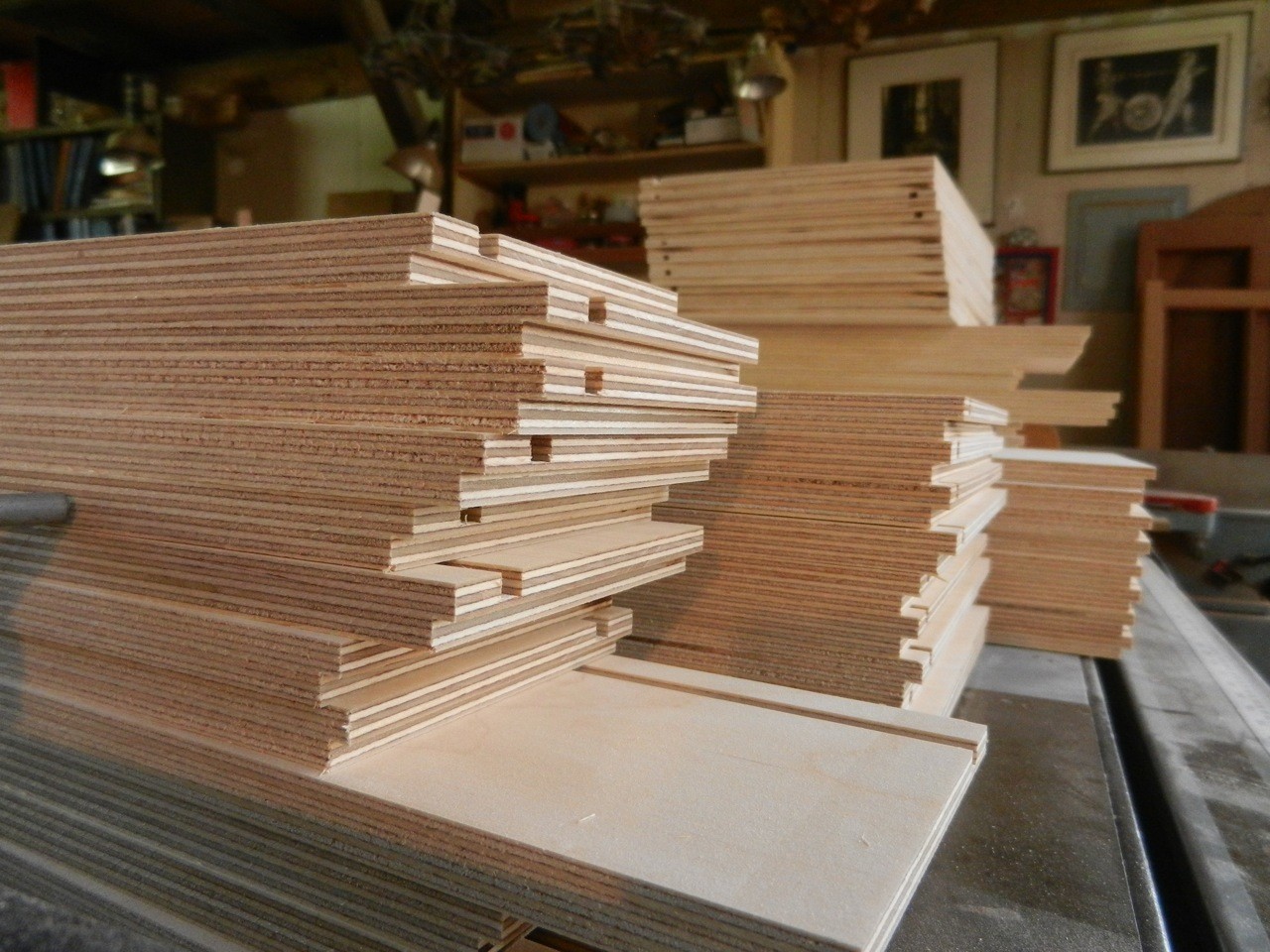Plywood has become a staple for construction and woodworking, since it was first invented in 1865. Although an American invention, plywood has been adopted worldwide, to the point where over two billion dollars worth of the plywood used in the United States is imported. Most of this imported plywood is made to US specifications; but that doesn’t mean that all plywood in the world is made to those specifications. Each country or region has its own specs, along with its own sizes for the plywood. Since most countries use the metric system, the plywood they produce is to metric sizes.
But not everything that falls into the category of plywood is used everywhere. Medium density fiberboard (MDF), which is commonly used for the manufacture of inexpensive furniture, is considered a plywood product. Yet it is banned by the Austrian, Danish, Spanish and Swedish governments, mostly due to the high amount of dust produced, which can be a health hazard.
More conventional plywood, made of layers of wood veneers, is produced throughout Europe. Even so, not all of the wide range of plywood products that are available in the US are produced in Europe. This is in part because there are less species of wood harvested for lumber in Europe, than there are in the United States and other parts of the world. All lumber harvested in Europe is ash, beech, fir, oak, scots pine, or spruce. Moving farther east, birch is a commonly harvested wood, from which Baltic birch plywood is made.
European Plywood Specifications
European plywood products are certified through the “CE” marking on the sheets, which indicate that the plywood has been manufactured to meet European specifications. There are three main specifications that apply to plywood manufactured in the European Union:
- EN 636: 2012 – Is the main specification for plywood, both for structural and non-structural applications. It creates the three different categories of plywood, based on their use:
- Class 1 – Dry conditions, for interior use, such as warm roof, timber frame, partition walls.
- Class 2 – Humid conditions, for use in protected exterior conditions, including cold roof, ground floors.
- Class 3 – Exterior conditions, where long exposure to weather is expected and the plywood will be fully exposed to the weather.
- EN 314-2 – Deals with plywood bond requirements. It defines the bond requirements for the three different classifications of plywood, used in dry conditions, humid conditions and unprotected exterior conditions.
- EN 13986:2004+A1:2015 – covers all European wood-based panels. It defines the performance characteristics and test methods for plywood, OSB (oriented strand board) and laminated veneer lumber. Panels used for construction within the European Economic Area for construction must be marked according to EN 13986.
It is easy to identify the class of European plywood, as it will always be marked on the sheets. EN 636-1, for example, will identify plywood that has been manufactured according to EN 636 to fulfill Class 1 requirements. It may also be stamped with a letter code for its intended application:
- S – For structural applications
- NS – For general, non-structural applications
European Plywood Sizes
While American plywood sheets are typically 4’x 8’, plywood manufactured for the European market or manufactured in Europe is generally square, with 1250mm x 1250mm (50” square) being the most common size. For commercial applications, plywood comes in sizes up to 3660mm square (144” square). The thickness of European plywood is measured in millimeters, although the most common sizes are comparable to the common American plywood thicknesses.
- 3mm is about 0.12”, roughly equivalent to 1/8” (0.125”)
- 6mm is about 0.24”, roughly equivalent to ¼” (0.25”)
- 9mm is about 0.36”, roughly equivalent to 3/8” (0.375”)
- 12mm is about 0.47”, roughly equivalent to ½” (0.5”)
- 15mm is about 0.59”, roughly equivalent to 5/8” (0.625”)
- 18mm is about 0.70”, roughly equivalent to ¾” (0.75”)
One significant difference, which makes European plywood and especially baltic birch plywood popular for furniture manufacturing, is that European plywood will have more plies than American plywood. 12mm European plywood will have 9 plies, as opposed to the 5 plies typically found in American plywood and 18mm European plywood will have 13 plies.

Baltic Birch
The most popular European plywood for use in the American market is Baltic Birch, sometimes called “Russian Birch.” Baltic birch has become a very popular plywood product, due to its superior characteristics, partially because of the strength of the Birch itself and partially due to the manufacturing process, where more layers of veneer are used and fewer voids are allowed. This provides for cleaner joinery and improved strength.
Baltic Birch furniture is often built without edge banding, allowing the contrast in the veneer layers to show, which provide an attractive appearance. The thicker face and reverse veneer layers allow for sanding, whereas most hardwood plywood sold in the United States has such thin veneer face and back layers that it is easy to sand through them.
It is the combination of many layers of veneer and almost no voids that has made baltic birch popular for furniture, especially furniture with a more industrial look. The strength of the plywood is excellent and it is extremely stable. It is much easier to cut clean joinery in Baltic Birch plywood than most American plywood, due to these characteristics. Even complex joinery, such as half-blind dovetails can be cut cleanly in Baltic Birch.
However, the grain pattern of Baltic Birch doesn’t make for the most attractive surfaces, especially since it is rotary cut, which minimizes the appearance of the grain. It does not accept stains well and should be stained with a gel stain or a wood dye to avoid a splotchy appearance. If a light colored, fine grain that is not highly noticeable is desired, the wood can be sanded and varnished, providing a nice appearance.
For a finer appearance, furniture made with Baltic Birch can be veneered with both paper-backed and solid wood veneers. Used in conjunction with hardwood edging, this makes for excellent quality furniture, which will be void-free.
The one drawback to using Baltic Birch over other plywood products is that the high number of veneer layers means there is more adhesive used in the manufacture of the plywood. As the hardened adhesives tend to be rough on cutting tools, those edges will probably dull faster, when working with Baltic Birch, than they will with other types of plywood. Even so, no special tooling is required for working with the plywood, as it can be cut with normal tools.




